As of 2020, 72 million people use Apple Music . That may be a lot less than the 130 million subscribers on Spotify Premium, but for a service that's only been around for five years, that's impressive.
And Apple Music has become increasingly important to Apple over the years – especially since it replaced iTunes in 2019.
To get started, you simply pay Apple $9.99/£9.99 per month and you can stream as much music as you like, as many times as you like, on as many devices as you like. You can do this from inside the stock Music app on your iPhone, iPad, iPod touch, or Apple Watch and Apple's HomePod speaker.
Even Android users can use the service, which might come as a surprise when Apple likes to wall-off its hardware and services – and in the name of spreading the Apple love, its music service is even supported on Amazon Echo speakers.
Apple Music also offers extensive music discovery channels including round-the-clock radio station 'Apple Music 1' (formerly known as Beats 1) featuring renowned radio DJs like Zane Lowe, as well as social features that aim to put artists and bands closer to their fans. It's all exciting stuff.
You'll definitely want to dig into Apple Music if you're interested in the Apple HomePod too – right now it's the only service the great-sounding speaker fully supports, though that's set to change, with Apple announcing "a new program to integrate third-party music services" at WWDC 2020.
[Update: Apple Music has announced that the Beats 1 radio station will be renamed 'Apple Music 1' and that two new stations are coming to the service. Apple Music Hits, will celebrate "everyone’s favorite songs from the ’80s, ’90s, and 2000s", while Apple Music Country is set to shine a spotlight on (you guessed it) country music. ]
The basics of Apple Music
Apple Music costs $9.99/£9.99 per month for a standard dose of all-you-can-eat music streaming or $14.99/£14.99 for a family package, which gives access for up to six people.
That pricing is the same as most of Apple Music's competitors, but the family plan is a nice addition and offers real value for money.
Don't even try listening on more than one device at the same time with a standard subscription – you'll be instantly be cut off on one of the devices.
Apple also currently offers a three-month trial, which is useful if you're considering a switch from Spotify.
Speaking of Spotify, it’s no secret that there’s fierce competition between Apple and Spotify for dominance over the music streaming space, and so far, Spotify is still winning that battle.
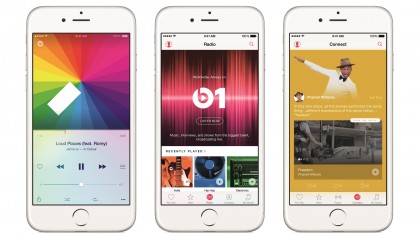
Focus on music discovery
The Apple Music library is 50 million tracks strong and growing – that's not quite as high as the number of tracks available in iTunes but on a par with Spotify and Google Music which are, lets face it, its biggest rivals.
Any music that you have in your own personal library that perhaps isn't available to stream you can upload to iCloud and have them seamlessly integrated with the other tracks that are natively available. You're limited to 100,000 tracks, but that shouldn't be a problem for most of us.
Setting up and exploring Apple Music
Apple Music is divided into five main areas, and you navigate between them using icons at the bottom of the mobile app or via buttons at the top of your iTunes screen.
It's worth exploring these one by one in this review as, for better or worse, they really do differentiate Apple Music from its competition.
Clearly from the way Music is designed the message is clear - Apple doesn't want Music to be a passive jukebox that simply plays the tunes you tell it to play. It's built from the ground up to learn what you like listening to and to suggest new bands, albums and curated playlists for you to enjoy.
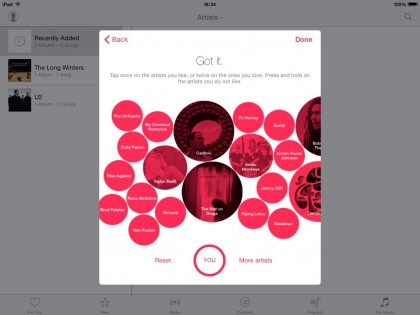
This process starts from the first time you log into the service. You're instantly confronted by a number of screens that ask you about the genres and bands you like the most.
You can go back and tweak these choices at any time by tapping the icon top left in the iOS app and selecting 'Choose artists for you'. And you can also 'heart' music as you go to continue fine-tuning your taste profile.

Apple Music: For You
From then on, the For You section of Apple Music will be populated by music Apple thinks you will enjoy – whether it's an old favourite you'd forgotten about, a playlist inspired by your love of reggae or a new album from one of your favourite bands.
The design of the page feels almost like browsing a magazine, and you do get the sense that there'll always be something interesting to choose from on this page.
The playlists are certainly the most interesting thing about For You. They're all curated by real music experts which adds a weight of authority to the recommendations you could never get from auto-generated radio stations.
The more we use Apple Music, the more we like this section.
If you want to log on and quickly put something on, there's usually something tempting in there even if it is just an "Introduction to Radiohead" playlist you theoretically shouldn't need because you've already told Apple you like Radiohead.
You can continually improve recommendations by 'hearting' the songs and albums you come across, thus telling Apple that you like them.
It's neat stuff, and different to what Spotify is doing.
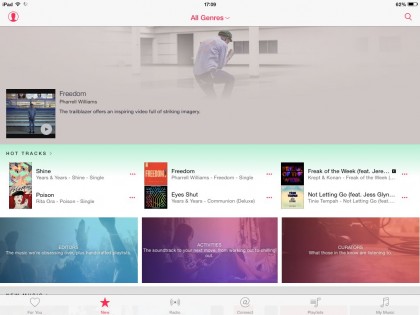
Apple Music: New
The New section of Apple Music points you towards new releases, top charts, topical playlists, hot new bands, recommended music videos and other genre-specific options.
It's probably the screen that will feel most familiar to those who use iTunes or even the other streaming services. It's a really good section that makes it super easy to find out what's hot both on Apple Music as a whole and in the genres you're particularly interested in.
You can't really fault this section, it's the most linear and straight forward part of Apple Music.
The latest addition to Apple Music's interface is Coming Soon, a sub-section of the New area. This one is simple.
You guessed it, Coming Soon simply tells you about important albums that will be available in the future, along with an expected date.

Apple Music: Radio
The Radio section is your way of letting Apple Music choose what you listen to. Apple Music 1 is obviously the big story here, with its 24-hour roster of superstar DJs and a focus on new music.
Apple Music 1 "anchors" include Zane Lowe, Matt Wilkinson, Julie Adenuga and Ebro Darden.
Whether "new music" to Apple means giving exposure to the indie stars of future or simply being the first to play Kanye West's latest deep sustained booming sounds remains to be seen - so far, it seems like a healthy mix of both.
For sure, this whole concept is a bit of a backwards idea, but it works.
Only Apple could pull off a global radio station like this, and while I can't imagine myself listening to it very often – or, let's be honest, ever – a lot of people do. So far, all the DJs are excellent, playing different types of music as well as interviews, chats and so forth. It's a proper live internet radio station.
The artist radio or album radio options you find on other services like Spotify or Google Music are there on this page, too, so you can get a Pandora-style playlist of music that the service thinks is similar to your selection.

Apple Music: Connect
Connect is the social network part of Apple Music. Just like Twitter or Instagram, you follow bands, artists or individual curators and then you'll get a feed with all the updates that these people choose to share.
It's a good idea, but Spotify's playlist community feels much more alive to us. Connect can seem like a marketing tool. And when you find someone who makes kick-ass playlists on Spotify, keeping an eye on what they create feels much more useful.
Of course, if you're a big fan of singer X, maybe their personal updates is exactly what you want.
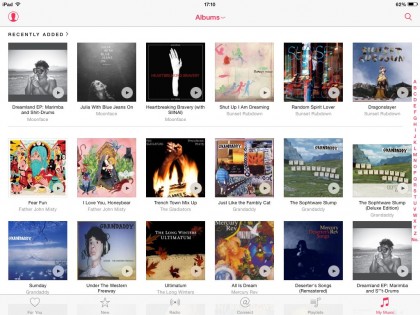
Apple Music: Playlists and Library
Library where all your own music is found, whether it be music that's physically on your device, in your iCloud account or music you've added to Music as a streaming option.
You can sort by artists, albums, songs, genres and composers and you can download albums or playlists to listen to offline.
One thing that Spotify and Tidal both do well is allow you to replicate your music collections digitally – they make you feel like you still own the music even though you don't. They make it very easy to get to the music you're looking for and they simulate that feeling you get from having a vast CD collection mounted on your wall.
In Apple Music all this stuff seems like a secondary consideration.
However, it has improved since the service's launch in 2015.
You can also now export tracks from Soundcloud into your Apple Music library.
At launch we weren't big fans of the Apple Music interface. However, since 2015 it has improved. It's cleaner, and makes better use of screen space.
In a few areas it seems to have been designed to be different from the competition just for the sake of being different. It's perhaps a little easier to navigate Spotify or Tidal.
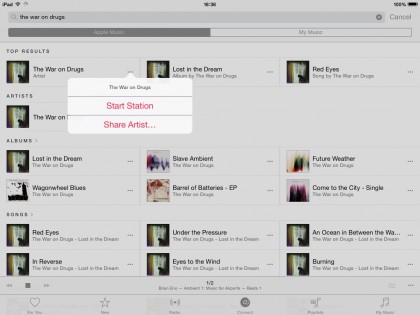

Social listening
Apple made it easier to find new music in iOS 11 with the introduction of a Spotify-like feature that highlights what your friends are listening to. You can set your Music profile to public or private but if it's pblic you can determine exactly what playlists you'd like to share and show your friends what you're listening to.
This means if you have one friend whose music taste you admire, you can get suggestions from them without even having to ask.
iOS 11 also added a new feature called 'Up Next' which will prove to be very useful for parties. With this feature you can set up a playlist and invite your friends to add their favorite track on their own, without interrupting the flow of the music.

Library
Apple Music over 45 million tracks – similar to Spotify and Google Music.
So most of the music we searched for was present and correct, but as with all music streaming services, there are also some glaring omissions. Apple has exclusive access to Taylor Swift's latest album, and other rare titles like In Rainbows by Radiohead. But it's also missing some albums that are available elsewhere.
It's par for the course in this territory, when you stream music you have to accept that not everything you look for will be available on your chosen service.
Extended API
Apple MusicKit opens up Apple Music to more third party developers which should make it more useful as a part of your overall mobile experience as it'll be integrated into more of the other apps you use every day.
Examples of apps that integrate Apple Music include Nike and Shazam. The Nike app will be able to intelligently work with Apple Music to get the best music for your workouts, and Shazam will now be able to automatically add the songs you find using it to your Apple Music library, saving your the trouble of finding it twice.
- Apple Music vs Spotify: which music streaming service is better?
Apple Music is a good streaming service with a different approach to curation than Spotify. Is it better than Spotify? No, but it's different.
However, if you are a big Apple fan who owns a bunch of their devices already, particularly the HomePod, subscribing starts to seem like a no-brainer.
We liked
There's a lot to feel happy about in Apple Music. The For You section has heaps of potential and the use of human curators makes a huge difference. It's always easy to find something to listen to and in that way it's better even than Tidal which also employs humans to create playlists.
The library too is up there with the best, and has the added benefit of including many albums that you won't find on other services. And while Beats 1 is something I can't see myself using much, I can see loads of people really getting on board with it. It's a modern twist on a very old idea and I think it works.
And of course, the killer feature is the three month free trial - you can't argue with free music.
We disliked
After a rocky start, Apple Music's interface is a lot better now than it was at launch. However, we still prefer Spotify's playlisting community, which feels more active and open.
Also, radio is a big part of Apple Music's appeal. And to some this may seem a little dated.
We also tend to find Spotify's recommendations algorithm comes up with more interesting suggestions, which is great if you want to discover new or lesser-known artists.
Verdict
For any 'Apple people' who've yet to try out streaming, this could well be a service that has you hooked immediately if you're willing to put up with some flaws and bugs.
But should you switch from Spotify? Its approach is different, with a new style of curation. However, as there's a three-month trial, why not give it a spin?
- Which is the best music streaming service for you?
from TechRadar - All the latest technology news https://ift.tt/2IjEmkN
via IFTTT
0 التعليقات: